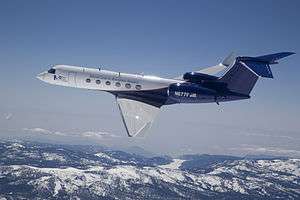High-performance Instrumented Airborne Platform for Environmental Research
| HIAPER | |
|---|---|
 | |
| NSF/NCAR Gulfstream V research aircraft | |
| Role | atmospheric research |
| Manufacturer | Gulfstream |
| Primary user | National Center for Atmospheric Research |
| Number built | 1 |
| Unit cost |
$80 million[1] |
| Developed from | Gulfstream V |
The High-performance Instrumented Airborne Platform for Environmental Research (HIAPER) is a modified Gulfstream V aircraft operated by the Earth Observing Laboratory at the National Center for Atmospheric Research (NCAR) in Boulder, Colorado. The aircraft was purchased brand-new from Gulfstream Aerospace in 2002 and then modified by Lockheed Martin in Greenville, South Carolina over a period of two years, for a total cost of $80 million.[1]
The aircraft includes a wing mounted cloud radar which allows researchers a high resolution view into snow producing storms.[2] The aircraft is designed and instrumented to observe and measure clouds from the stratosphere.[3][4]
The HIAPER cloud radar (HCR) is an airborne, polarimetric, millimeter-wavelength radar capable of cloud remote sensing.[2] Whole air samplers also collect air samples for later analysis on the ground.[5]
Data collected by the 2013 HIAPER Pole-to-Pole Observations (HIPPO) campaign is publicly available.[5]
References
- 1 2 "HIAPER Project Office > What is HIAPER?". ucar.edu. Retrieved 4 February 2015.
- 1 2 Johnson, Nate. "Advanced radar makes maiden voyage". WRAL. Retrieved 3 February 2015.
- ↑ "HIAPER (High-performance Instrumented Airborne Platform for Environmental Research) Project Office". ucar.edu. Retrieved 3 February 2015.
- ↑ "HIAPER: THE NEXT GENERATION NSF/NCAR RESEARCH AIRCRAFT". Bulletin of the American Meteorological Society. 87 (7): 896–909. July 2006. doi:10.1175/bams-87-7-896. Retrieved 3 February 2015.
- 1 2 "HIPPO global-scale air chemistry dataset now available". Harvard School of Engineering and Applied Sciences. Retrieved 3 February 2015.